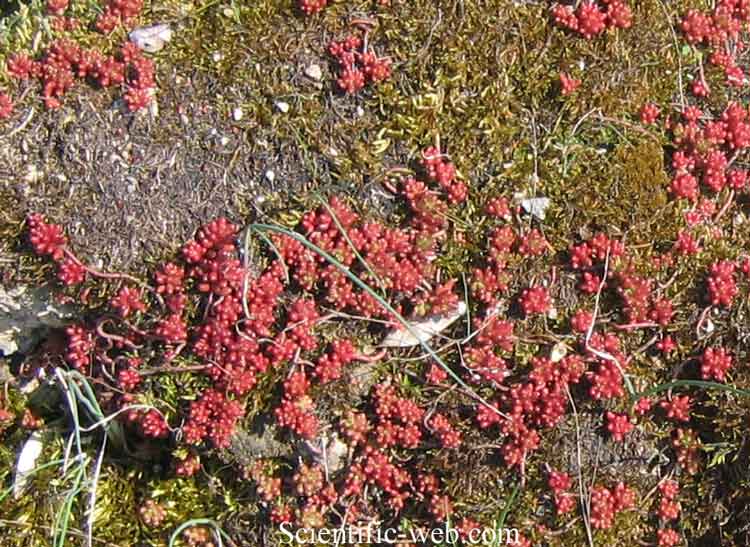
Sedum album, Photo: Michael Lahanas
Classification System: APG IV
Superregnum: Eukaryota
Regnum: Plantae
Cladus: Angiosperms
Cladus: Eudicots
Cladus: Core eudicots
Ordo: Saxifragales
Familia: Crassulaceae
Subfamilia: Sempervivoideae
Tribus: Sedeae
Genus: Sedum
Sectio: S. sect. Sedum
Series: S. ser. Alba
Species: Sedum album
Subspecies: S. a. subsp. album – S. a. subsp. rupi-melitense – S. a. subsp. serpentini
Name
Sedum album L., Sp. Pl. 432 1753.
References
Primary references
Linnaeus, C. 1753. Species plantarum, exhibentes plantas rite cognitas, ad genera relatas, cum differentiis specificis, nominibus trivialibus, synonymis selectis, locis natalibus, secundum systema sexuale digestas. Tomus I. Pp. [I–XII], 1–560. Impensis Laurentii Salvii, Holmiae [Stockholm]. BHL Reference page. : 432.
Links
Hassler, M. 2019. Sedum album. World Plants: Synonymic Checklists of the Vascular Plants of the World In: Roskovh, Y., Abucay, L., Orrell, T., Nicolson, D., Bailly, N., Kirk, P., Bourgoin, T., DeWalt, R.E., Decock, W., De Wever, A., Nieukerken, E. van, Zarucchi, J. & Penev, L., eds. 2019. Species 2000 & ITIS Catalogue of Life. Published online. Accessed: 2019 Dec 06. Reference page.
International Plant Names Index. 2019. Sedum album. Published online. Accessed: Dec 06 2019.
Govaerts, R. et al. 2019. Sedum album in Kew Science Plants of the World online. The Board of Trustees of the Royal Botanic Gardens, Kew. Published online. Accessed: 2019 Dec 06. Reference page.
Tropicos.org 2019. Sedum album. Missouri Botanical Garden. Published online. Accessed: 06 Dec 2019.
Castroviejo, S. et al. (eds.) 2012. Sedum album in Flora Ibérica. Plantas vasculares de la Península Ibérica, e Islas Baleares. Published online. Accessed: 2012 Aug 29. Reference page.
Tela Botanica (ed.) 2000 onwards: Tela Botanica. Le réseau de la botanique francophone. eFlore. Sedum album. Association Tela Botanica, Montpellier, France. Accessed: 2012 Aug 29.
Euro+Med 2006 onwards: Sedum album in Euro+Med PlantBase – the information resource for Euro-Mediterranean plant diversity. Published online. Accessed: 2012 Aug 29.
Vernacular names
العربية: سدم أبيض
català: Crespinell blanc
čeština: Rozchodník bílý
Cymraeg: Briweg Wen
dansk: Hvid Stenurt
Deutsch: Weiße Fetthenne
English: White Stonecrop
español: Uva de gato
eesti: Valge kukehari
فارسی: ناز سفید
suomi: Valkomaksaruoho
français: Orpin blanc
magyar: Fehér varjúháj
norsk bokmål: Hvitbergknapp
Nederlands: Wit vetkruid
polski: Rozchodnik biały
português: Arroz-dos-telhados
slovenčina: Rozchodník biely
svenska: Vit fetknopp
українська: Очиток білий
Sedum album, the white stonecrop, is a flowering plant of the genus Sedum in the family Crassulaceae. It is found in the northern temperate regions of the world, often growing in crevices or free-draining rocky soil. As a long-day plant it grows vegetatively for most of the year and flowers in summer.[1]
Taxonomy
Three subspecies album, micranthum (Bastard ex DC.) Syme and teretifolium Syme have been described. [2][3][4]
Description
White stonecrop is a tufted perennial herb that forms mat-like stands. Much of the year the stems are short, semi prostrate and densely clad in leaves. At the flowering time in July and August, the stems lengthen and are erect, occasionally branched and often pinkish-brown. The leaves are alternate, fleshy and nearly cylindrical with a blunt, rounded tip. They are also sometimes tinged with pink, especially in drought-stressed plants. The starry flowers form a dense cyme. The calyx has five fleshy sepals fused at the base, the corolla consists of five regular white petals, there are ten stamens, a separate gynoecium and five pistils. The fruit is five united, many-seeded follicles.[5]
Habitat
White stonecrop is a low-growing plant that cannot compete with more vigorous fast-growing species. It is specially adapted for growing on thin dry soils and can be found on walls, dry banks, seashore rocks and in rocky meadows.[5]
Physiology
Sedum album is able to acclimate to its environment. It can switch between C3 carbon fixation and crassulacean acid metabolism (CAM) depending on the availability of water. CAM saves water as the stomata on its leaves only open to allow CO2 to diffuse into the leaves at night when the temperature (and therefore evapotranspiration) is lower.[6] Drought stressed plants are also more susceptible to photoinhibition which CAM may help to protect against.[1]
Cultivation
Hardy in Zones 3-9.[4]
The plant on the left is relatively drought stressed and the one on the right is well watered
References
Castillo, F J (9 December 2004). "Antioxidative protection in the inducible CAM plant Sedum album L. following the imposition of severe water stress and recovery". Oecologia. Springer Berlin / Heidelberg. 107 (4): 469–477. doi:10.1007/BF00333937. PMID 28307389. S2CID 23864025.
Natural History Museum: Sedum album subsp. album
Tela Botanica. Sedum album
Missouri Botanical Garden: Sedum album subsp. teretifolium 'Murale'
"White stonecrop: Sedum album". NatureGate. Retrieved 29 December 2013.
Earnshaw, M. J.; Carver, K. A.; Lee, J. A. (1985). "Changes in leaf water potential and CAM in Sempervivum montanum and Sedum album in response to water availability in the field". Oecologia. 67 (4): 486–492. Bibcode:1985Oecol..67..486E. doi:10.1007/BF00790018. PMID 28311032. S2CID 21923282.
Retrieved from "http://en.wikipedia.org/"
All text is available under the terms of the GNU Free Documentation License

